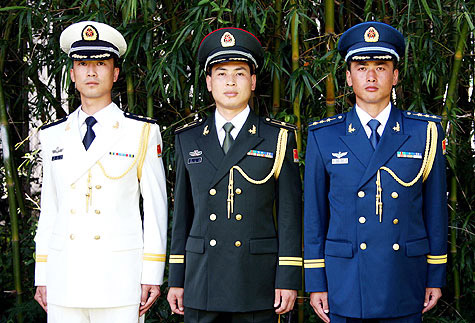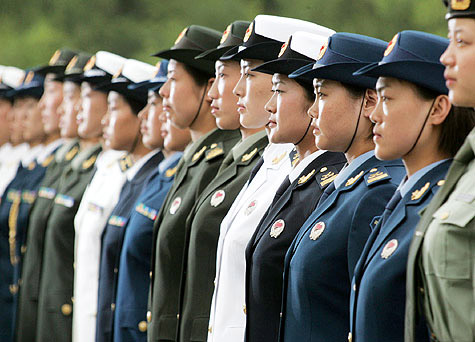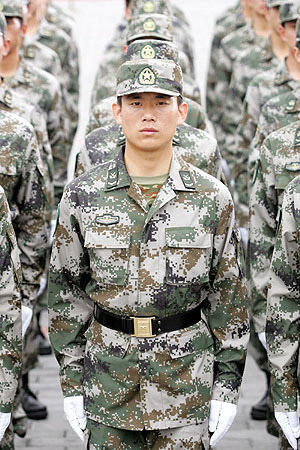| Home / China / Military Affairs / News | Tools: Save | Print | E-mail | Most Read |
| Armed Forces Go Stylish |
| Adjust font size: |
Now that the vast majority of Chinese civilians have adopted western-style clothes and trendy urbanites on the hunt for cool items in tune with world fashion trends, the 2.3 million people serving in the country's military are also doing a style catch-up. Brand new ceremonial and casual uniforms -- and new battle fatigues -- were unveiled in Hong Kong on July 1, the 10th anniversary of Hong Kong's return to China, unleashing a loud hurrah from the mainland's enlisted men.
Different from the "97 Style" uniforms issued to garrison troops in Hong Kong and Macao, this upgrade will allow the mainland's enlisted to cast off the baggy uniforms developed some 20 years ago and look even sharper than the garrison troops in Hong Kong and Macao. Dubbed "07 Style", the new ceremonial uniforms for the first time adopt chest insignia, a mainstay of most western military uniforms, to reveal wearers'ranks and length of service. Berets have been introduced as standard-issue summer headgear, reminiscent of the NATO look, while Navy rank badges move down from the shoulders to the sleeves in line with international practice. Years of peace-keeping operations with other international forces have influenced Chinese designers. "Increasing global military exchanges have upped the requirements for PLA uniforms. The new outfits fuse global trends with Chinese characteristics," said general Liao Xilong, chief of the PLA General Logistics Department, in an interview with Xinhua. The current outfits are not very stylish, Liao said, there are often color mismatches and insufficient varieties to meet the different dress needs of the forces. Apart from battle fatigues, military personnel need basic casual uniforms and ceremonial dress uniforms. Rising living standards, the modernization of the country's armed forces and its growing presence in international peacekeeping operations are also factors behind the decision to upgrade uniforms. Stylish uniforms Working from the"97 Style", designers refined the cut and the sizing of the uniforms to enhance the appearance of the wearers. The new casual uniform for spring and autumn fit more tightly because they have been taken in the chest, waist and bust. Female servicemen will find their shoe heels have grown by a centimeter from the previous four centimeters. Designers focused mainly on improving the aesthetics, quality and functionality of military outfits, said senior engineer Yang Tingxin, president of the Quartermaster Equipment Institute (QEI) responsible for the uniform designs. "It would be impossible to carry out such a major upgrade if the country's economic strength hadn't grown rapidly," he said. Technological and financial constraints meant that up until 1987 Chinese forces were only issued one uniform for working, field surveys and training when casual uniforms were first introduced. "Letter H uniforms have been ditched once and for all, they're a thing of the past," said Wu Yu, a QEI senior engineer. "Now we have letter T uniforms for men and letter X for women". When compared with military uniforms from other countries, H-shaped uniforms appear baggy and dull. Men in T-shaped uniforms that highlight shoulder breadth look taller and stronger; women in X-shaped uniforms featuring contracted waists are much sassier, she explained. Ceremonial dress uniforms previously reserved for military attaches when they were first deployed in 1987 are now available to all military officers. Tailor-made, they come complete with special shoes and shirts. After three years of study, designers made more than a hundred refinements to the "97 Style" and introduced 365 new items including sweaters, training boots, gloves, socks, training overcoats and apparel such as arm badges, name patches and service insignia. "My impression is that the top leaders of the military really want to make the rank-and-filers look smart and feel comfortable. They are very open-minded," said Yang Tingxin, who was involved in the design of "87 Style". The red band that has been a feature of the big-brimmed green Army hats for decades has disappeared from the new outfits. Some critics opposed the change, saying that the color red is the main symbol of the Communist Party of China. But aesthetics prevailed. The blaze of red didn't match the green hat and green uniforms. Instead designers have come up with an enlarged peach-shaped badge on the hats for all enlisted bearing the insignia of the PLA Army, Air Force and Navy. A red relief features a star and the Chinese characters "ba-yi", or eight-one, commemorating the beginning of the Nanchang Uprising on Aug. 1, 1927, to which the history of the PLA was officially traced. Tradition persists Despite the changes, the uniforms retain "key PLA elements and icons"--- under the command of the Communist Party of China, serving the people and performing bravely and skillfully in battles, Liao said. A dozen traditional icons appear on the new uniforms including the national flag, the PLA flag, the Great Wall, Tian'anmen Square, as well as ears of wheat and cog wheels representing the alliance of farmers and workers which 80 years ago led to the foundation of the New China. To commemorate the history of the PLA, historic gray -- the color worn by the Red Army (1927 to 1937) and the Balujun or Eighth Route Army (1937-1949) from which the PLA evolved -- was fused with the current colors, providing a new pine green for the Army, dark blue for the Navy and deep grey-blue for the Air Force. "The three colors mesh well and accord with the global trend of using cold colors for military uniforms," said Yang Tingxin, adding that there won't be much change in the colors and categories of Chinese military uniforms in the future. "Our focus will shift to improving functionality, quality and recognizability and enriching standard-issues for each category", he said. "Training and tactical uniforms need more work." The upgrade will cost China six billion yuan by 2009. But, despite this, the per capita bedding and clothing expenses of the Chinese armed forces remains low compared with the world average, Liao Xilong noted. "The expenditure cannot be avoided. But we must budget strictly. By spreading the upgrade over three years, we can make full use of existing inventory and avoid waste," he said. Logistical breakthrough Carefully folded uniforms usually arrive at the barracks from military warehouses. This year, many ceremonial uniforms have come direct from factory production lines. Delivered on clothes hangers, they are without a single wrinkle and have the name label of the wearer stitched on. "This military dress upgrade is a stride forward in the PLA's logistics management," said Wang Zongxi, Professor at the PLA Logistics Command Institute. Liao Xilong admitted that the PLA had long wanted to provide servicemen and women with tailor-made ceremonial uniforms. "The upgrade has taken us a long way towards achieving this goal," he said. Manufacturers that won contracts to produce the new ceremonial uniforms have been required to take the measurements of the country's 2.3 million military. This massive undertaking has made it possible to deliver tailor-made uniforms to every eligible wearer direct from factories to barracks. Liao said that the Army would no longer keep inventory and no longer be involved in inventory management for ceremonial uniforms. "The idea is to outsource inventory management of these uniforms to private firms and slash our storage costs." Technological innovation, industrial advances and military reforms are blurring the divide between defense and civil industries. Many countries use resources from the private sector to reduce the size of their military forces and improve their combat effectiveness. This is a key focus for the PLA in modernizing its logistics, Liao said. In February, the Chinese military authorities urged military areas and units to collaborate more with civil enterprises in order to improve logistics management. The government said in late June that it was encouraging weapons makers in less sensitive sectors to attract private and overseas investors and increase innovation. "A uniform upgrade is not just about looking'snappy'. It is part of a whole system of logistics. The new design concept, new materials and new technologies improve uniform quality but they are also hooked in to optimized management of bedding and clothing," Liao said. Thanks to the largest-ever uniform upgrade in China's history, quartermasters have been able to update measurement statistics and data on bedding and clothing, and they predict that they will be able to significantly reduce costs related to uniform and equipment issue errors. "Uniforms are an excellent point of departure for experimenting with the outsourcing of military logistics," he said. (Xinhua News Agency July 3, 2007) |
| Tools: Save | Print | E-mail | Most Read |
 |
| Related Stories |



